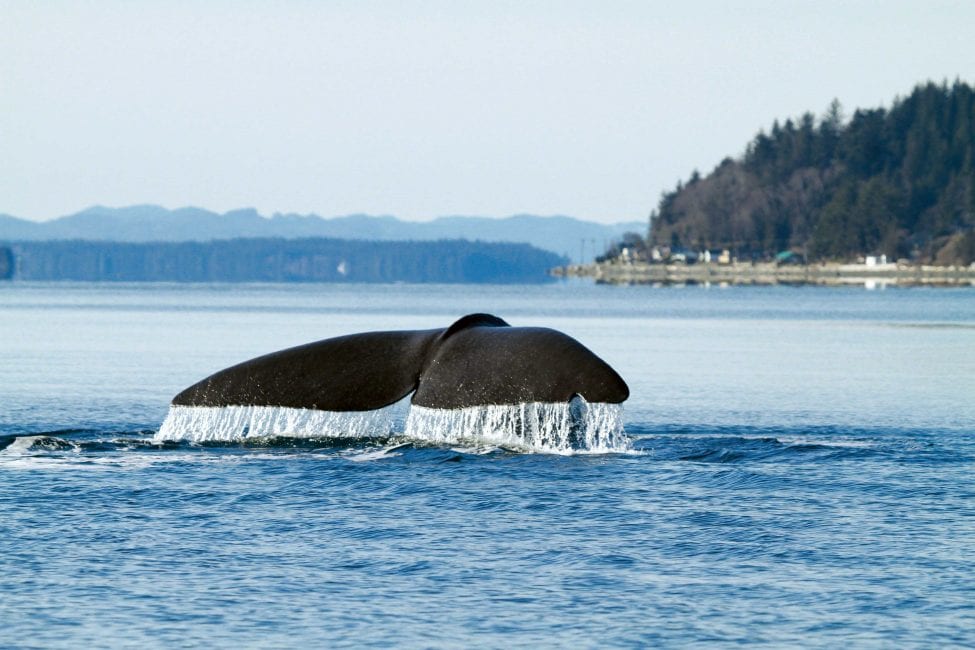The Lone Stranger
For whale researchers off the coast of British Columbia, humpbacks and orcas are run of the mill and are identified by the sounds coming from hydrophones. So when quite different clicks were heard the scientists knew that an exciting newcomer was visiting.
When I first heard the message from Lisa, I was certain that something was amiss. She was looking after OrcaLab, a remote whale research station at the northern end of Vancouver Island, and for the past three months had been its only occupant. Her message was cryptic; she didn’t want to tell me on voicemail about what had just happened. When I finally did make contact with her, I was puzzled by her words. ‘You won’t believe what I’ve been listening to over the hydrophone for the past four hours,’ she said. Of course I had no idea – it was obviously not the call of an orca or a humpback, as they are quite common in the area. It must have been something she hadn’t heard before.
Suddenly it hit me. ‘Please tell me you’re listening to a sperm whale!’ She confirmed with an excited ‘Oh yeah!’ Lisa and I are lucky in that we live in the company of orcas and humpback whales, but we shared a hidden desire to one day see or hear a sperm whale. Stories of these lone giants were surrounded by mystery and had stirred a yearning in our hearts since childhood.
The sperm whale has a culture all its own, quite different from that of the humpback or orca. The females maintain strong bonds with one another and are known to spend their entire lives in pods, generally in warmer waters near the equator. They are the care-givers for the calves. Males born into these pods stay with the group until they are between four and 20 years old. When they depart, they may form groups with other males roughly the same age that have also left their families and together they mature and grow larger. By the time they reach their early 20s, individuals are ready to split from these male groups and become loners, often frequenting higher latitudes.
The largest of the toothed whales, the sperm whale can measure up to 18.3 metres (60 feet) long, although this is true only of the males; at maturity they are 30% to 50% longer and three times heavier than the females. The species’ shape is quite unusual, making it unlikely to be confused with any other whale. From the massive, square-shaped head a straight horizontal line leads down the back, where the vertebrae stick out slightly above the rest of the body, ending in a surprisingly large dorsal hump. Beyond this hump the tail and flukes usually hang below the surface. Even more telling is the shape of the blow – I have always found it interesting that you can identify a whale from a distance by its blow. In the case of the sperm whale, the blow is bushy and, since the blow hole is located on the left at the very front of the whale’s head, it is angled 45 degrees to the left (if not affected by wind).
We assumed that this lone sperm whale arriving in Johnstone Strait in early February was a male. Lisa, who had first heard him on one of the many hydrophones of the OrcaLab array, sent the recording to Paul and Helena (the founders of OrcaLab 47 years ago and the inspiration for Cetacea Lab). They forwarded it to a few colleagues and soon everyone was in agreement – these were indeed the clicks and creaks of a sperm whale. Excitement spread through the communities along the coast – a sperm whale had not been seen or heard in these inside waters since 1984, when John Ford recorded one but never saw it. We all assumed this whale would hang around for a few days and then be on its way. Fortunately, this was not the case.
Jared Towers, one of British Columbia’s top orca biologists, lives in a small coastal town called Alert Bay, 30 minutes by boat from OrcaLab. He asked Lisa to call him the next time she heard the whale on the hydrophones. He didn’t have to wait long. At first light the following day she called to say the sperm whale was back on the easternmost hydrophone. It took Jared less than an hour to pack up the boat and fetch Lisa. Fortunately, the weather was sunny and fairly calm, perfect for trying to see the blow of this lone whale.
Second only to beaked whales as deep divers when foraging, sperm whales can dive up to two kilometres (1.2 miles) for up to an hour at a time. Their diet comprises mainly giant and medium-sized squid, but they are also known to feed on octopus and some fish species; in the open waters of British Columbia sable fish is a favourite. Since their dive time is so long, when they return to the surface to breathe and rest they remain there for quite a long time before diving again. This is what Lisa and Jared were hoping for, so that they could take a few identification photographs before the whale left the area. They also had a portable hydrophone so they would know when the whale would most likely be at the surface. After a couple of anxious hours of looking for blows and listening for clicks, they finally made out in the distance a bushy blow – it had to be the sperm whale!

